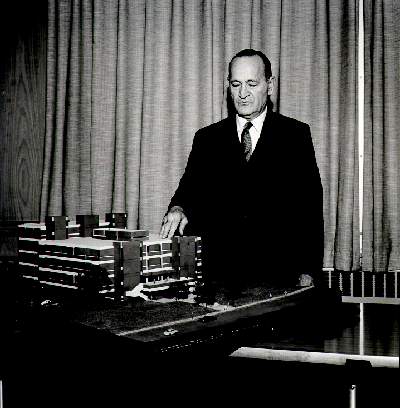

| After thirty-nine years, Dr. Herbert D. Welte retired as president of the college. During his tenure, President Welte led the development of the institution from a two-year normal school to a multi-purpose college. His accomplishments were remarkable despite the problems caused by the Great Depression, World War II, frequent cutbacks in funding, and an enrollment explosion. |
| President Welte with model of the new library. |
His replacement was Dr. F. Don James.
By the end of the 1960s the library was able to report holdings of over 165,000 volumes and subscriptions to 1,000 periodicals. Despite the impressive growth in the collection, book orders continued to pile up. The new president resurrected the faculty library committee. Faculty were unhappy with the allocation of library funds. At this time there was a significant increase in newly hired faculty. The new faculty, many with doctoral degrees, expected to a find library that would support their research projects.

| Construction for the new library began in 1969. The site was so swampy that it was necessary to drive massive piers to support the tremendous weight of the building and its collections. |
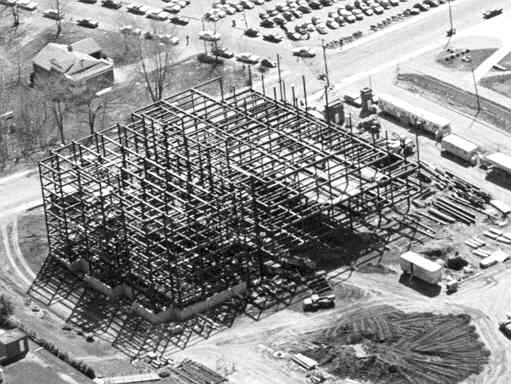
| Aerial view of the Burritt Library under construction, circa 1969-1970 |

|
Notice the remains of the gate in the foreground in the picture above. This gate once led to the football field. By the summer of 1972, the new library building was complete. In August over 175,000 books and 1,000 pieces of furniture were moved into the new building. The relocation involved a moving company, forty-five student workers, and the entire library staff. This massive operation was completed in five working days.
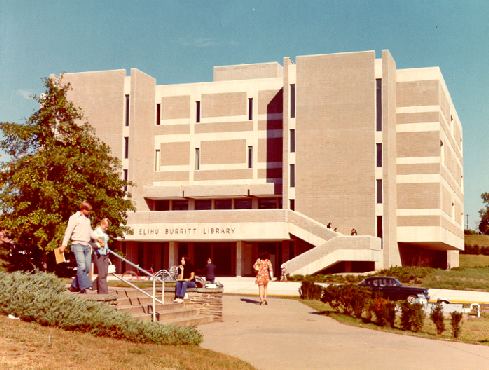
|

|

| During the tour of the building, Dr. James pointed out to the Governor all of the empty shelves, Governor Meskill replied, "You purchased too much shelving." |
Unfortunately, the prime furniture contractor, Walkerbilt filed for Chapter 11. The result was that for over a year there were no chairs, tables or bookcases in the Special Collections, Reference, and Serials departments. Staff were forced to operate out of boxes.

| Scene in Reference department, 1973. |

| Scene in the Technical Processing department. Dan Danko, Catalog librarian. Notice the high-tech manual typewriters. |
The new library was the recipient of several major donations. Professor Reginald LeGrande Swann donated a 38,000 item psychology collection. Several hundred volumes and periodicals were received from retired professor Franklin Lindquist, and several hundred volumes in political science came from Professor Emeritus Jesse B. Johnson. The records of Herbert D. Welte's thirty-nine years as president were also transferred to the library.

|
In the early 1970s under the leadership of Professor Stephen Bacon, a Friends of the Library Group was created. The Friends provided a variety of interesting programs and held several successful book sales to benefit the library.
In 1972, the Elihu Burritt had one of the earliest semi-automated circulation systems in the state. The system used the old IBM 38 column cards and a porta punch. The system was designed by Jay Jannace from the data center.
The Vietnam War and the Arab oil embargo in the mid 1970s resulted in further cutbacks in appropriations to the campus. Financially things became so desperate that the Student Senate allocated $20,000 in student fees for the purchase of library books in 1978. The financial situation further deteriorated in 1979, forcing the administration to eliminate weekend hours. By October 13th, students occupied the library and refused to leave until college administrators listened to their grievances.
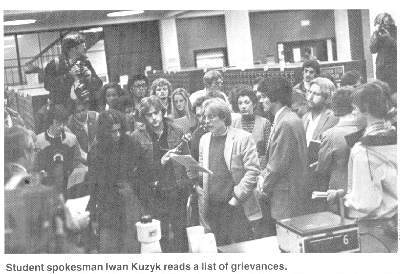
|
|
What is really important [is] that a broad coalition of student and faculty groups are fighting back the cuts in these days of "lowered expectations" (read "higher interest rates"). And with the combined efforts of Iwan Kusyk, Brian Kelly, Jack Gagne, and Ann Gilbert. The United Student Front Against Cuts provided that the occupation worked. -Central Recorder Oct. |
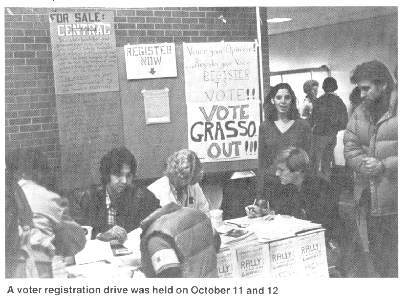
|
In addition thousands of students staged a rally in Hartford to protest the budget cuts of Governor Ella Grasso.
In early October a rare tornado struck Connecticut. While high winds caused extensive destruction in the Windsor Locks area, it was the rains that affected the library. In addition to leaks, the brook running through campus went over its banks. The ground floor of the library was flooded with three inches of water that carried mud, leaves, and grass through the rooms and corridors. Water rose to a depth of a foot along the exterior of the north wall of the building.

| 
| 
|
| Back | Return to main history page | Next |